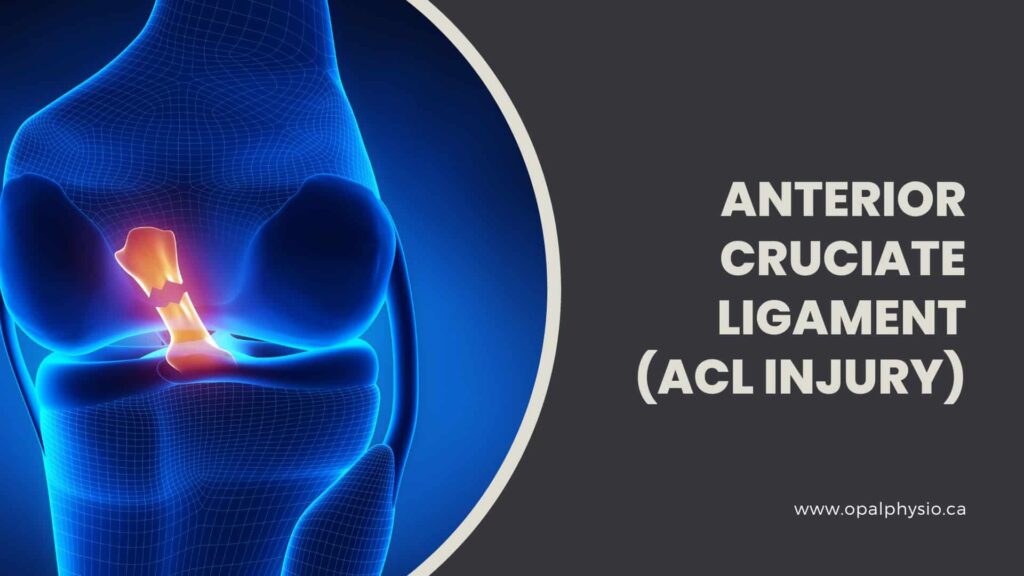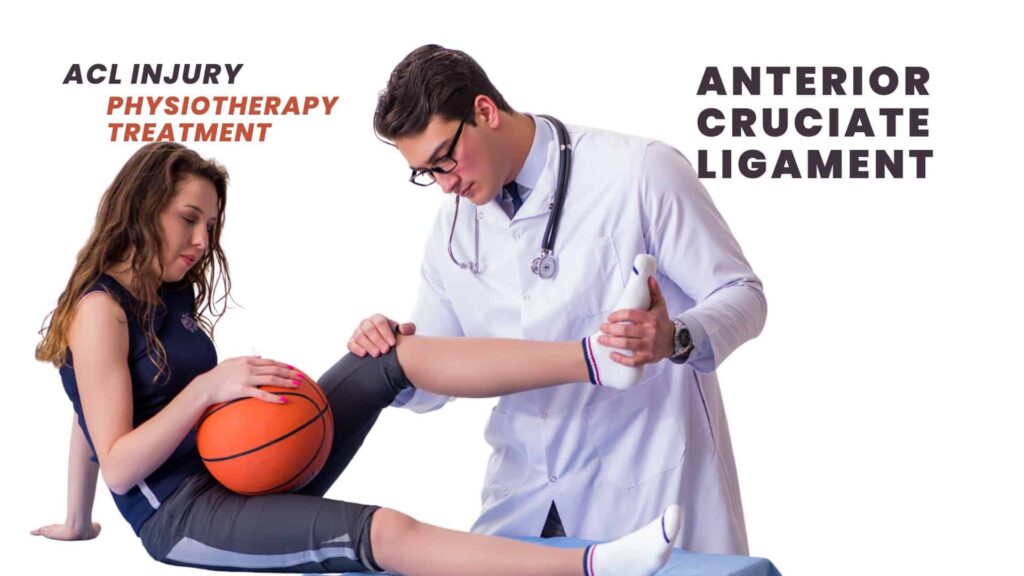Anterior Cruciate Ligament – ACL Injury
Anterior Cruciate Ligament Tear
The anterior cruciate ligament (ACL) is a major ligament in the knee. It provides stability to the knee joint and is often injured when a person suffers a direct blow to their knee or when they twist their knee.
Conservative treatment for an ACL injury/tear often includes physiotherapy, which can help gain the range of motion and improve strength. Physiotherapy will also help the patient recover from injury and return to normal activities at the earliest.

What is anterior cruciate ligament (ACL)?
The ACL is one of the four major ligaments which connects the femur bone to the tibia bone. The ACL helps stabilize the knee by preventing excessive forward motion and helps to keep the tibia from sliding in front of the femur, which can cause misalignment of the knee joint and may lead to further injury.
What is an ACL tear?
ACL tear is a common injury that can happen to anyone participating in any sports activity. It results from a sudden forceful twisting of the knee or when a person lands on their foot heavily after jumping or running.
ACL injuries are most common in sports such as football and soccer, where athletes constantly change directions at high speeds. This sudden change in direction can cause a person’s body weight to shift too far forward and put stress on their knees.
Tearing ACLs can be devastating for athletes as it causes them to lose their ability to play sports at their best level.
Symptoms of ACL Injury
Symptoms of an ACL injury or tear can vary from person to person and may also depend on how severe it is.
Some common symptoms of an anterior cruciate ligament injury include:
Treatments available for ACL Tear
Treatment for ACL tears will depend on the severity of the tear, the patient’s activity level, and the patient’s general health.
The key steps in acute ACL injury treatment are:
Anterior cruciate ligament injury treatment options
Conservative treatments“ include:
Surgical treatment: Reconstruction of ACL surgery is the most common way to repair torn ligaments and restore basic stability.
Tips for preventing ACL injuries
Preventing ACL injuries involves maintaining strong and flexible muscles surrounding the knees. Some ways to prevent ACL injuries include:
- Developing strength in the hips and thigh muscles
- Improving flexibility, balance, and agility
- Practicing proper jumping, landing, stopping, and moving techniques
- Ensuring that the knees are directly over the feet during movements
- Avoiding inward knee collapse

How can physiotherapy help with anterior cruciate ligament (ACL) injury?
Physiotherapy is the most promising conservative treatment to help people with ACL tears. It plays a crucial role in recovering from an ACL injury, helping patients regain strength, stability, and function in their knee and allowing them to safely return to their desired activities.
The main goal of physiotherapy for ACL injuries is to restore the knee’s full range of motion, strengthen the surrounding muscles, and improve stability. Physiotherapy usually begins as soon as possible following an ACL tear, and rehabilitation can last anywhere from 6 weeks to 6 months.
Physiotherapy can help with an ACL tear by providing rehabilitation exercises and treatments that will help increase blood flow, aid in healing, and reduce swelling in the injured area. The physiotherapist will assess the patient and create a treatment plan for recovery. This plan will be based on the individual’s needs and goals.
In the acute stage of an ACL injury, physiotherapy focuses on reducing swelling and pain, attempting a full range of motion, and decreasing joint effusion. Techniques such as Compression, Elevation and modalities can be used to achieve these goals.
Specific exercises are prescribed to target the strengthening of the hip and core muscles, which can help prevent future injuries by identifying biomechanical factors that may have contributed to the injury in the first place, such as poor posture or faulty running technique.
Some exercises may include heel slides, quad sets, hamstring curls, long sitting towel calf stretch, supine hamstring stretches, ankle pumps, and shallow standing knee bends.
Physiotherapy can also help patients who have undergone ACL surgery. Post-surgical rehabilitation typically involves wearing a knee brace, stretching, strengthening, and range-of-motion exercises. Our physiotherapist will guide patients through these exercises and monitor their progress, gradually increasing the intensity of the exercises as the knee regains strength and function.
In addition to strengthening exercises, physiotherapy can help improve proprioception and balance, which is essential for a safe return to sports and other activities. Physiotherapists can also teach patients exercises to perform at home as part of home recovery. They can also guide them in modifying their physical activities to put less stress on the knee and prevent future injuries.
With proper physiotherapy treatment and adherence to a rehabilitation program, many individuals can return to their pre-injury level of functioning and maintain an active lifestyle.
Call us to learn how our Langley physiotherapist at Opal can help with your ACL Injury and rehabilitation through structured physiotherapy sessions. We can also help patients improve their muscle strength and joint range of motion while awaiting surgery or if they have already had surgery by providing post-surgical rehabilitation. Call us at 604-532-7887 to learn more.
Know more about the conditions treated at our physiotherapy clinic
